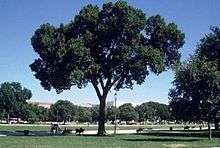Ulmus americana 'Jefferson'
| Ulmus americana | |
|---|---|
 'Jefferson' elm in The Mall, Washington D. C. | |
| Cultivar | 'Jefferson' |
| Origin | National Park Service, USA |
The American Elm cultivar Ulmus americana 'Jefferson' was cloned from a tree that grows along the National Mall in Washington D. C. . Planted in the 1930s, it remains (2013) unscathed by Dutch elm disease, and was cloned (NPS 3487) by the U. S. National Park Service, which released it as 'Jefferson' in 2004. Early studies on this clone indicated triploid chromosome levels, suggesting it may be a hybrid between the tetraploid American Elm and a diploid species. A genetic study performed by the United States National Arboretum in 2004 confirmed the tree as Ulmus americana, despite its atypical features.[1] A later study by the USDA's Agricultural Research Service confirmed the tree as a triploid, but derived from a crossing of two American Elms, one a tetraploid, the other a rarer diploid.[2]
Description
'Jefferson' is distinguished by its low, spreading form with arching limbs and broad U-shaped crotches; the tree in the National Mall has attained a height of about 21 m (68 ft) after 80 years.[3] Ploidy: 2n = 42.
Pests and diseases
The tree proved highly resistant to Dutch elm disease in USDA trials (as clone N 3487/NA 62001),[4] and very resistant to the Elm Leaf Beetle Xanthogaleruca luteola . No specific information is available, but the species generally is highly susceptible to Elm Yellows and highly preferred for feeding by the Japanese Beetle Popillia japonica [5] in the United States. U. americana is also the most susceptible of all the elms to verticillium wilt.[6]
Cultivation

'Jefferson' has not been widely tested beyond Washington D.C., although it is now being evaluated in the National Elm Trial coordinated by Colorado State University. The tree was introduced to the UK in 2010 by the Golden Hill Nursery in Kent, but remains rare in cultivation.
Accessions
North America
- Bartlett Tree Experts . Acc. nos. 2001-255/6/7.
- Longwood Gardens. Acc. no. 2002-0413.
- U S National Arboretum , Washington, D.C., United States. Acc. nos. 76448, 76625, 57844.
Europe
- Grange Farm Arboretum, Sutton St James, Spalding, Lincolnshire, UK. Whips planted 2011. Acc. no. 1053
External links
- DNA Fingerprinting of Clones and Hybrids of American Elm and Other Elm Species with AFLP Markers. Summary of a genetic study which suggests strongly that the Jefferson elm is tetraploid.
- http://www.elmpost.org/2005-02.htm Photograph showing the mature form of the Jefferson elm.
- http://www.sunshinenursery.com/elms.htm Review of current elm selections in the USA.
- http://fletcher.ces.state.nc.us/programs/nursery/metria/metria11/warren/elm.htm Return of the Elm -the status of elms in the nursery industry in 2000. Warren, K., J. Frank Schmidt and Co.
References
- ↑ Pooler, M. R. & Townsend, A. M. (2005). DNA Fingerprinting of Clones and Hybrids of American Elm and Other Elm Species with AFLP Markers. Journal of Environmental Horticulture, 23 (3): 113-117. September 2005.
- ↑ Kaplan, K. (2011). Hidden elm population may hold genes to combat Dutch elm disease. ARS News, 30 March 2011. USDA.
- ↑ Photographs of mature and young 'Jefferson' elms on the National Mall, Washington DC: 'Elms of the Monumental Core', James L. Sherald, National Park Service (2009), p.38
- ↑ Townsend, A. M., Bentz, S. E., and Douglass L. W. (2005). Evaluation of 19 American Elm Clones for Tolerance to Dutch Elm Disease. Journal of Environmental Horticulture, March 2005, Horticultural Research Institute, Washington, D.C.
- ↑ Miller, F., Ware, G. and Jackson, J. (2001). Preference of Temperate Chinese Elms (Ulmuss spp.) for the Feeding of the Japanese Beetle (Coleoptera: Scarabaeidae). Journal of Economic Entomology 94 (2). pp 445-448. 2001. Entom. Soc.of America.
- ↑ Pegg, G. F. & Brady, B. L. (2002). Verticillium Wilts. CABI Publishing. ISBN 0-85199-529-2